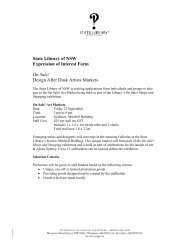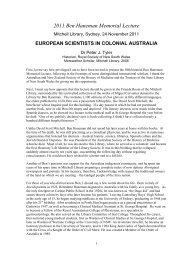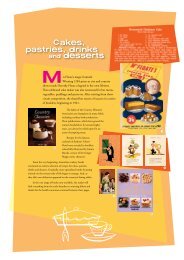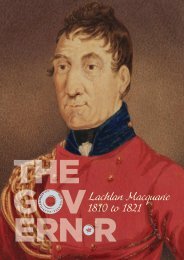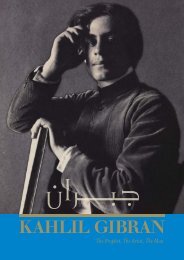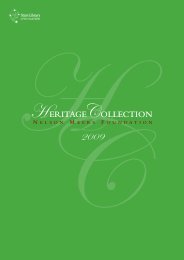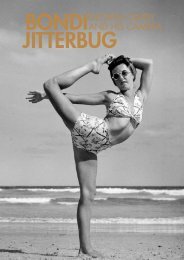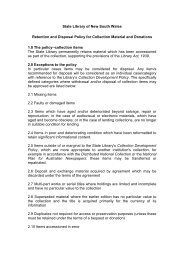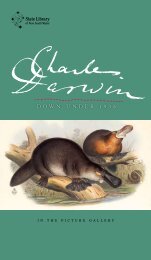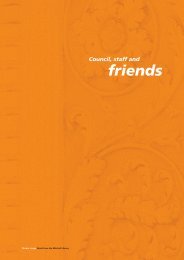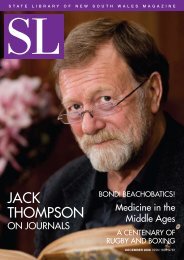Countdown to Mitchell centenary - State Library of New South Wales
Countdown to Mitchell centenary - State Library of New South Wales
Countdown to Mitchell centenary - State Library of New South Wales
Create successful ePaper yourself
Turn your PDF publications into a flip-book with our unique Google optimized e-Paper software.
In July 1948 Sydney audiences were<br />
treated <strong>to</strong> the first complete collection<br />
<strong>of</strong> Christian Dior’s revolutionary<br />
‘<strong>New</strong> Look’ fashions shown outside<br />
Paris. Through pho<strong>to</strong>graphs, personal<br />
papers and magazines, cura<strong>to</strong>r<br />
Margot Riley has uncovered surprising<br />
insights in<strong>to</strong> the events that led <strong>to</strong><br />
this defining moment. It’s the s<strong>to</strong>ry<br />
behind this year’s sell-out Pret-aporter<br />
Fashion Parade, presented<br />
by the <strong>Library</strong> at the S<strong>of</strong>itel Sydney<br />
Wentworth.<br />
lefT: madame<br />
ChambrelenT models The<br />
signaTure ‘bar’ suiT from<br />
ChrisTian dior’s firsT<br />
‘neW look’ ColleCTion,<br />
auStralian Women’S<br />
Weekly, 9 augusT 1947<br />
beloW: ‘sTyle symposium<br />
from paris’, auStralian<br />
Women’S Weekly,<br />
21 sepTember 1946<br />
opposiTe: baCk sTage,<br />
deparTmenT sTore<br />
fashion parade, mark<br />
foy’s, sydney, marCh 1947,<br />
Pix arChiVe, aCp<br />
From wine and wool <strong>to</strong> food and fashion, the French<br />
have always had a thing or two <strong>to</strong> teach Australians<br />
about the art <strong>of</strong> combining business and pleasure.<br />
Having supplied the French fashion industry with<br />
wool for nearly a century, Australia became an eager<br />
participant in the global market for French style after<br />
World War II.<br />
Anxious <strong>to</strong> cut out the British middle men, French<br />
textile companies had been buying wool directly<br />
from Australia since the 1850s. When the wool trade<br />
<strong>to</strong>ok <strong>of</strong>f during the second half <strong>of</strong> the century, France<br />
became Australia’s largest cus<strong>to</strong>mer after Britain.<br />
By 1900, Australia was leading the world in the<br />
production <strong>of</strong> fine merino wool and many French<br />
wool-buying firms had representatives stationed<br />
here permanently.<br />
It is hard <strong>to</strong> overestimate the influence <strong>of</strong> the<br />
wool-buyers and their coterie on Australian attitudes<br />
<strong>to</strong> French culture at this time. Bringing with them a<br />
taste for Parisian luxuries and the sophistication <strong>of</strong><br />
European city life, the elegant subset <strong>of</strong> Sydney<br />
society (known as le <strong>to</strong>ut-Sydney) ensured that a<br />
French fixation thrived.<br />
This was an era in which an elegant woman<br />
might change outfits four times a day — for travelling,<br />
lunching and visiting, going <strong>to</strong> the races, cocktails,<br />
dinner and balls. But only the very wealthy could<br />
s l m a g a z i n e Summer 2009/10 / <strong>State</strong> <strong>Library</strong> <strong>of</strong> <strong>New</strong> <strong>South</strong> <strong>Wales</strong> / 11



